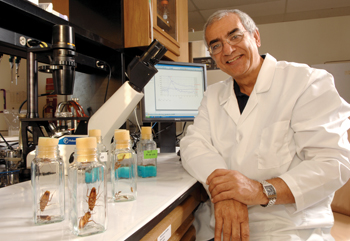
Research by Essam Enan, Ph.D., led to the formation of TyraTech, which recently went public. (photo by Anne Rayner)
Vanderbilt insect-fighting technology goes public
A broken air conditioner got Essam Enan, Ph.D., thinking. He noticed something odd that summer day when the laboratory building's doors were open.
“There were flies everywhere in the building, but not in my lab,” recalled Enan, research professor of Biochemistry at Vanderbilt. “I realized I was the only one in the building using essential oils, and I started to wonder about the connection between these oils and insects.
“It was pure coincidence.”
A literature search revealed that other scientists had made a similar connection that some essential oils — plant oils with distinctive aromas — have insecticidal activity. But Enan was interested in how the oils work at a molecular level, something that wasn't in the publications.
After coming to Vanderbilt in 1999, he established a screening platform to investigate the oils' insect-killing actions. The platform became the core technology for the company TyraTech, formed by Vanderbilt and XL TechGroup in 2004 to develop safe, natural products for controlling insects and human and animal parasites. TyraTech hit a milestone earlier this year: it became the first publicly traded company based solely on a Vanderbilt technology.
TyraTech has signed agreements with multiple companies to license and distribute its non-toxic insecticide formulations for crop protection and personal care products and with Kraft Foods Inc. to develop food additives aimed at preventing human intestinal parasite infections in the developing world.
“TyraTech is a great example of how universities and the private sector can partner to export university research to advance the public good,” said Harry Jacobson, M.D., vice chancellor for Health Affairs. “It should be especially gratifying to the Vanderbilt community that this technology may not only have a positive impact on the global environment, but also potentially on public health in countries where parasitic diseases are particularly devastating.”
For Enan, the path his research has taken is especially gratifying. In his early research career, he studied the adverse effects of pesticides, especially the cancer-causing potential of synthetic organochlorine chemicals, and the build-up of these chemicals in the environment.
“The toxicity of these chemicals really bothered me, so when I saw an opportunity to find safer alternatives (essential oils are generally regarded as safe), I poured my energy into it,” Enan said.
To investigate how essential oils repel and kill insects, Enan first simply exposed insects to various essential oils and observed their responses — for example, excitation and extension of the hind legs or abdomen.
Mostly, the insects responded differently to the oils than to traditional pesticides, Enan said. But one group of oils caused the same signs of toxicity in insects as pesticides containing the active ingredient chlordimeform, banned in the United States in 1984. The mode of action of this chemical was known: it blocked the octopamine receptor, a neurotransmitter receptor found in insects, but not in humans.
The link was an “aha” moment for Enan. He used cockroach brain preparations to characterize the interaction of essential oils with the octopamine receptor. And he started considering other insect-specific targets including another neurotransmitter receptor (tyramine) and aroma-sensing receptors. He came to the conclusion that the best approach for understanding how essential oils work would be to isolate the insect-specific genes, express them in cells, and use the cell model system as a screening tool.
“I was able to clone several insect genes and develop the clonal cell lines,” Enan said. “I screened hundreds of essential oils and came to realize that they target specific proteins based on their chemical structure and how they fit certain receptor binding sites.”
As he gathered more and more information about which oils target which receptors, he began to put together combinations of oils to create “synergistic blends.” Because such blends target multiple different proteins, they are usually more effective than single agents. Insect resistance — through genetic mutation — is also less likely with blends.
Recognizing the potential of his findings, Enan approached Vanderbilt's Office of Technology Transfer & Enterprise Development. Brian Laden, Ph.D., senior associate in the office, said the technology transfer group was somewhat skeptical at first. But they sent some of “Essam's special sauce” to an insect repellant testing group, and the experimental oil blend compared favorably to insect repellants on the market.
The Technology Transfer & Enterprise Development team worked with Enan and XL TechGroup to form TyraTech, which derives its name from “tyramine,” one of the first insect receptor genes Enan isolated.
“XL TechGroup did a tremendous job developing the company,” said Kenneth Holroyd, M.D., M.B.A., assistant vice chancellor for Research. “They embraced the potential of this technology and over just a few years secured agreements with major companies and took TyraTech public.”
“This story is a terrific example of Vanderbilt impacting society through our innovations,” said Jeffrey Balser, M.D., Ph.D., associate vice chancellor for Research. “Essam, through insightful observation and study, has translated a number of chance discoveries into a series of natural insecticide products, some of which will soon be commercially available.
“TyraTech is Vanderbilt's greatest life sciences entrepreneurial success story.”













